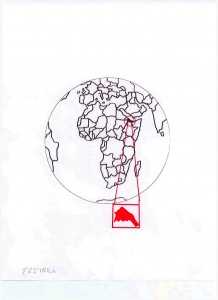ERITREA
A. THE COUNTRY
The State of Eritrea is a country in the Horn of Africa with an
extensive coastline on the Red Sea. The Dahlak Archipelago and several
of the Hanish Islands are part of Eritrea. There has been a single
president since 1993 who has espoused Marxist ideology, postponed
elections several times, clamped down hard on freedoms and placed such
restrictions on international organizations that they left the country.
Eritrea is in and out of conflict with neighbouring countries, most
notably with Ethiopia. Due to war, drought, land destruction and
degradation, food production amounts to a fraction of what is needed to
feed the population. There is some development of infrastructure and of
the mining industry.
B. THE PEOPLE
The population is ~5,224,000 and official language Tigrinya. Tigre,
Arabic and English (especially in education) are widely used.
Many face extreme poverty. Facing mandatory military careers, many
young people flee Eritrea, which can bring reprisals against family
members left behind. Government possession of nearly all land and
enterprise has accelerated the exodus of most of the highly educated and
skilled professionals. ~87.1% are Horn of Africa People (Semitic, Afar,
Other), ~5.1% Nilotic, ~7.8% Arab.
C. RELIGIONS AND CHRISTIANITY/PENTECOSTALISM
There is recognition of four religious groups: Sunni Islam, Orthodox,
Roman Catholic and Lutheran. All others have been persecuted
(imprisonment and severe torture) with increasing intensity since 2002.
Even those officially recognized groups must endure government
appointments and interference. Evangelicals are growing and operate in
underground networks. ~50.26% are Muslim. ~47.31% claim to be
Christian, ~1.87% Non-religious, ~0.56% Ethnoreligionist.
In the Christian category:
~41.87% are Orthodox, ~3.43% Catholic, ~1.39% Protestant, ~0.31%
Independent, ~0.3% Unaffiliated, ~0.1% are considered ‘marginal’.
Evangelicals represent ~2.1% of the population.
Charismatics represent ~1.2% and of those 0.2% are Pentecostals.
Donna Siemens
References:
http://
LIBYA
A. THE COUNTRY
Libya is a country in north Africa that is mostly Sahara desert with
only a coastal Mediterranean strip and 2% arable land.
As a result of the 2011 Civil war, there are currently two entities
claiming to be the official government. They are: The Tripoli-based
regime of Muammar Gaddafi, which controls the western half and calls the
country the “Great Socialist People’s Libyan Arab Jamahiriya” and,
the Benghazi-Based Transitional National Council which controls most of
the eastern half and calls the country the “Libyan Republic”.
Oil accounts for 95% of export income, but little of this wealth
trickles down to the masses.
B. THE PEOPLE
This fourth largest country in Africa is home to 6.5 million people.
Population data is difficult since undocumented foreign migrants may be
as much as 25% of Libya’s population. All figures are estimates:
Arab and related 95.9% (Arab 76.4%, Berber 5.8%, Bedouin 13.7%)
Others 4.1%
The official language is Arabic.
C. RELIGION AND CHRISTIANITY
Sunni Islam is the state religion and the Gaddafi government has
endorsed a moderate form of Islam. Evangelism of Libyan citizens is
illegal. All faiths are free to worship at home, but meetings of more
than six people is illegal. These laws are not often enforced.
All figures are approximations:
97.2% Muslim, 2.6% Christian, 0.3% Non-religious, 0.03% Buddhist, 0.01%
Hindu. Or those in the Christian category:
1.19% Orthodox (Coptic and Greek), 1.22% Catholic, 0.14% Protestant,
0.01% Independent.
Evangelicals represent 0.3% and Charismatics 0.2%, and consist almost
exclusively to exiled people living in or in transit through Libya.
Donna Siemens
References:
http://en.wikipedia.org
Operation World, Jason Mandryk. Colorado Springs: Biblica Publishing, 2010.

